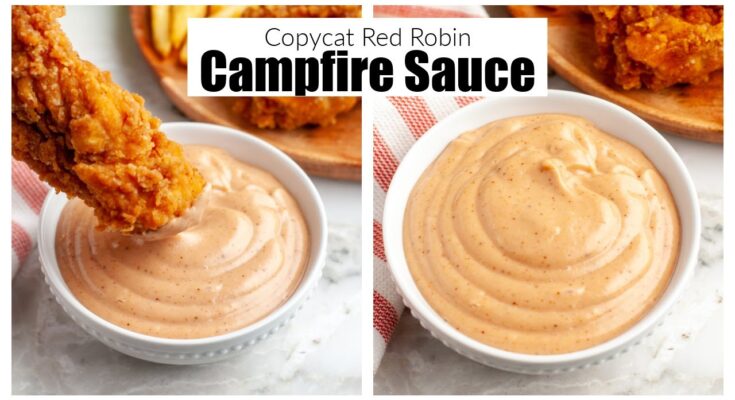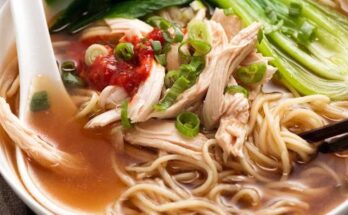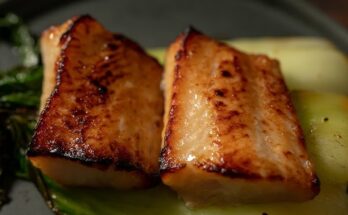Campfire Sauce Recipe: Who doesn’t love a good sauce that’s creamy, smoky, slightly tangy, and with just the right kick? If you’ve ever dipped your fries into that dreamy, zesty, smoky sauce at Red Robin or a local BBQ spot and thought, “I need this in my life all the time,” then you’re in for a treat. Welcome to the ultimate guide on how to make Campfire Sauce at home. This is your all-in-one, tried-and-true recipe with expert tips, ingredient swaps, and storage advice.
Campfire Sauce isn’t just another condiment. It’s the kind of sauce that becomes a staple once you try it. It’s perfect for dipping fries, drizzling on burgers, using as a marinade, or even as a bold salad dressing. You can whip it up in minutes with simple pantry staples and elevate any dish from average to amazing.
The Magic of Campfire Sauce
Campfire Sauce is all about balance. It’s creamy yet smoky, tangy yet sweet, with a hint of spice that sneaks up on you in the best way. What makes this sauce stand out is its ability to complement nearly everything you pair it with. From grilled meats to crispy veggies, it turns any meal into a flavor explosion.
Imagine mixing the rich creaminess of mayo with the zesty sharpness of BBQ sauce, the heat of chipotle, and a dash of garlic and paprika. That’s the flavor profile we’re talking about. It brings a smoky campfire vibe straight into your kitchen, hence the name.
List of Ingredients You’ll Need
Here’s the beauty of Campfire Sauce—you don’t need anything fancy. Most of these ingredients are probably already sitting in your fridge or pantry. But for the best flavor, quality matters. Go for full-fat mayonnaise and a robust BBQ sauce for depth.
Main Ingredients:
- Mayonnaise (½ cup): This is your creamy base. Use real mayo for the best texture.
- BBQ Sauce (¼ cup): Pick a smoky, tangy variety—something with molasses is ideal.
- Ketchup (2 tbsp): Adds sweetness and acidity to balance out the smokiness.
- Chipotle Peppers in Adobo Sauce (1 tbsp, minced): The key to that bold, smoky heat.
- Garlic Powder (½ tsp): Adds that warm, garlicky undertone.
- Smoked Paprika (½ tsp): Enhances the smoky profile even more.
- Worcestershire Sauce (½ tsp): Gives it that deep, umami richness.
- Salt (to taste): Enhances all the flavors.
- Black Pepper (to taste): Adds a touch of heat and sharpness.
Optional Add-ins:
- Hot Sauce: For those who want a fiery kick.
- Lemon Juice or Vinegar: A splash can brighten the flavor.
- Brown Sugar or Honey: A touch of sweetness balances the spice.
Substitutions:
- Vegan Mayo: Works perfectly if you’re avoiding eggs.
- Low-Sugar BBQ Sauce: Ideal for keto or diabetic-friendly versions.
- Greek Yogurt: For a lighter, tangier variation.
Tools and Equipment Required
You won’t need anything fancy here. Just basic kitchen essentials:
- Mixing Bowl
- Whisk or Spoon
- Measuring Cups and Spoons
- Storage Container (preferably airtight)
If you want to be extra precise or make a large batch:
- Food Processor (for a smoother texture)
- Glass Jars (for storage or gifting)
Step-by-Step Guide to Making Campfire Sauce
Let’s get to the fun part—making the actual sauce. This step-by-step guide ensures you get perfect results every time.
Step 1: Gather All Ingredients
Before you begin, set everything out on your countertop. This ensures you don’t forget anything, and it makes the process much smoother. Chop the chipotle peppers finely so they blend well into the sauce.
Step 2: Mix the Wet Ingredients
In a medium mixing bowl, add the mayo, BBQ sauce, and ketchup. These are your base ingredients. Stir them together until they’re fully combined and creamy.
Step 3: Add the Spices and Seasonings
Toss in the garlic powder, smoked paprika, Worcestershire sauce, salt, and pepper. If you’re feeling adventurous, now’s the time to add your hot sauce or sweetener. Stir everything thoroughly until no lumps remain.
Step 4: Whisk It All Together
Use a whisk to beat the mixture until smooth. This helps emulsify the ingredients and gives the sauce a rich, velvety texture. You’ll see the color turn into a beautiful smoky pinkish-brown hue.
Step 5: Let It Rest and Chill
This step is crucial. Letting the sauce chill in the fridge for at least 30 minutes allows the flavors to meld and intensify. Trust me, it’s worth the wait.
Step 6: Taste and Adjust
Once chilled, give it a taste. Need more heat? Add a dash of chipotle. Want it sweeter? Stir in a pinch of brown sugar. Don’t be afraid to tweak it until it’s just right for you.
Pro Tips for Perfect Campfire Sauce
Getting the flavor just right can feel like a balancing act, but with a few smart tricks, you’ll be making restaurant-quality Campfire Sauce every single time.
How to Balance the Flavor
- Too spicy? Add a little extra mayo or a small spoonful of sugar to tone it down.
- Too bland? Try a dash more Worcestershire sauce or a pinch of salt.
- Too thick? Add a teaspoon of milk, cream, or even lemon juice to thin it slightly without losing flavor.
- Too sweet? A squeeze of lemon or a splash of vinegar can bring back the zing.
Don’t be afraid to play around a little. Your taste buds are the best judge.
Storage Tips
Always store your Campfire Sauce in an airtight container, preferably glass. Mason jars are perfect—they seal tight and look great in the fridge.
- Keep it chilled at all times.
- Stir it before each use to recombine the ingredients.
How to Thicken or Thin the Sauce
- Thicker sauce? Mix in a spoon of sour cream or more mayo.
- Thinner sauce? Add a splash of water, milk, or lemon juice. Just go slow—thin it in small increments.
Campfire Sauce Variations
One of the best things about this sauce? It’s a blank canvas. You can tweak it endlessly to match your mood, your meal, or your dietary needs.
Smoky BBQ Twist
- Use a hickory-flavored BBQ sauce.
- Add a few drops of liquid smoke.
- Perfect for ribs or brisket sandwiches.
Spicy Chipotle Campfire Sauce
- Double up the chipotle peppers.
- Add cayenne or sriracha.
- Great for spicy chicken wings or tacos.
Vegan-Friendly Option
- Use vegan mayo and Worcestershire substitute (many Worcestershire sauces contain anchovies).
- Make sure your BBQ sauce is vegan-certified.
- Still creamy, smoky, and delicious—no animals harmed.
Low-Calorie Version
- Swap mayo for non-fat Greek yogurt.
- Choose a sugar-free BBQ sauce.
- Skip the ketchup or use a no-sugar-added version.
Serving Suggestions
Now that you’ve got your Campfire Sauce ready, here comes the fun part—eating it! This sauce is incredibly versatile. Here are some delicious ways to use it:
As a Dip
- French fries
- Onion rings
- Chicken tenders
- Mozzarella sticks
It’s like ketchup and mayo got married and went to BBQ heaven.
As a Burger Sauce
- Slather it on the bun.
- Mix it into ground beef for smoky flavor.
- Drizzle it on top of the patty for maximum impact.
Drizzle on Roasted Veggies
- Roasted cauliflower? Yes.
- Grilled corn? Oh yeah.
- Sweet potato fries? Absolutely.
It adds a smoky, tangy lift that makes veggies feel indulgent.
You can also use it in wraps, sandwiches, tacos, or even on scrambled eggs if you’re feeling bold. The sky’s the limit!
How to Store and Preserve Campfire Sauce
Once you’ve made your perfect batch of Campfire Sauce, you’ll want it to last—and taste great—every time you open the jar.
Refrigeration
- Store in an airtight container (glass is best).
- Keep in the fridge at 40°F (4°C) or lower.
- Best if used within 7–10 days.
Label your jar with the date you made it—easy reference and food safety win.
Freezing Tips
Yes, you can freeze Campfire Sauce, but here’s the catch: mayo-based sauces can separate when thawed.
If you must freeze:
- Use a freezer-safe container.
- Stir well after thawing, and be prepared for a slight texture change.
Shelf Life
- Refrigerated: Up to 10 days
- Frozen: Up to 1 month (texture may be altered)
Remember: if it smells funky or separates badly, toss it.
Health Considerations
Let’s be real—it’s not a diet food, but it doesn’t have to be a total indulgence either.
Nutritional Value (per 2 tbsp serving):
- Calories: 100–120
- Fat: 10g
- Carbs: 3–5g
- Protein: 0–1g
- Sugar: 2–4g
Low-Fat Alternatives
- Greek yogurt instead of mayo
- Sugar-free ketchup or BBQ sauce
Allergy Info
- Contains eggs (mayo), soy (some BBQ sauces), and possibly gluten
- Make adjustments if allergic or use allergen-free alternatives
History and Origins of Campfire Sauce
There’s no single inventor of Campfire Sauce, but Red Robin made it famous. Their smoky BBQ-mayo combo took the internet (and our taste buds) by storm. It mimics the taste of food grilled over open flames—hence the “campfire” name.
Many versions exist across the country, especially in BBQ joints and fast-casual burger spots. It’s now a DIY favorite in kitchens everywhere.
Why Homemade is Better Than Store-Bought
Why buy it in a bottle full of preservatives when you can make a fresher, tastier, and customizable version at home?
- No preservatives or artificial junk
- Control the flavor and spice level
- Make it vegan, keto, gluten-free, or sugar-free
- Save money over time
Once you try it homemade, you’ll never go back.
Mistakes to Avoid When Making Campfire Sauce
Even the simplest recipes can go sideways. Avoid these rookie errors:
- Wrong ratios: Too much BBQ can overpower. Stick to the 2:1 mayo-to-BBQ ratio.
- Not chilling the sauce: Skipping this step gives you a flat, unbalanced flavor.
- Over-seasoning: A little goes a long way with garlic powder, salt, and chipotle.
- Using low-quality ingredients: The better your BBQ sauce and mayo, the better your final flavor.
FAQs about Campfire Sauce Recipe
Let’s knock out some of the most common questions people have about this addictive sauce.
Is It Gluten-Free?
Yes—if you use gluten-free versions of BBQ sauce and Worcestershire. Always read your labels!
Can I Use It As a Marinade?
Absolutely. It’s amazing on chicken, steak, and even tofu. Just marinate for 2–4 hours before grilling.
What If I Don’t Like Mayo?
Try Greek yogurt or sour cream for a different twist. You’ll get similar creaminess with a tangier profile.
How Spicy Is It?
Mild to medium, depending on how much chipotle you use. Want it hotter? Add jalapeño or hot sauce.
How Long Does It Last?
7 to 10 days in the fridge. Always check for freshness before using.
Conclusion
Campfire Sauce is one of those magical condiments that makes everything taste better. Whether you’re dipping, drizzling, or marinating, it adds smoky depth, creamy texture, and just the right kick to whatever you’re eating.
Making it at home is simple, fast, and way more satisfying than grabbing a bottle off the shelf. You control the flavor, the spice, the texture, and the ingredients. That’s the beauty of homemade.
So go ahead, make a batch today. Your fries—and your taste buds—will thank you.



